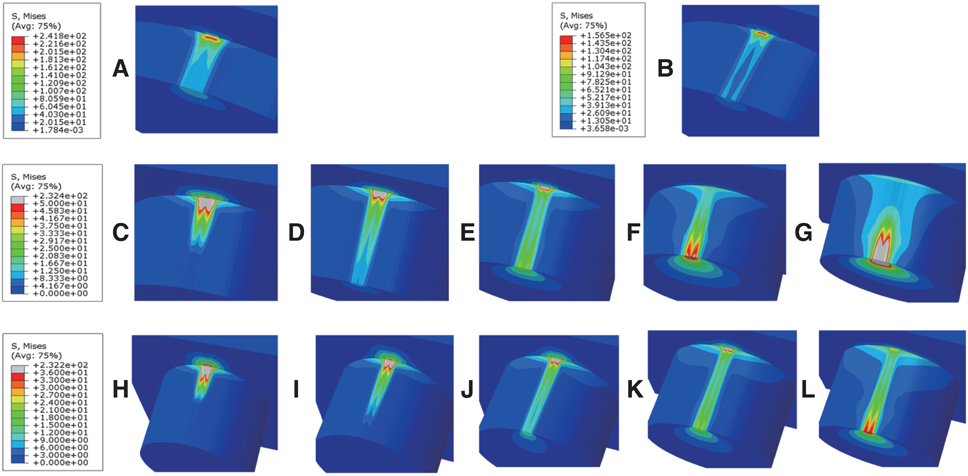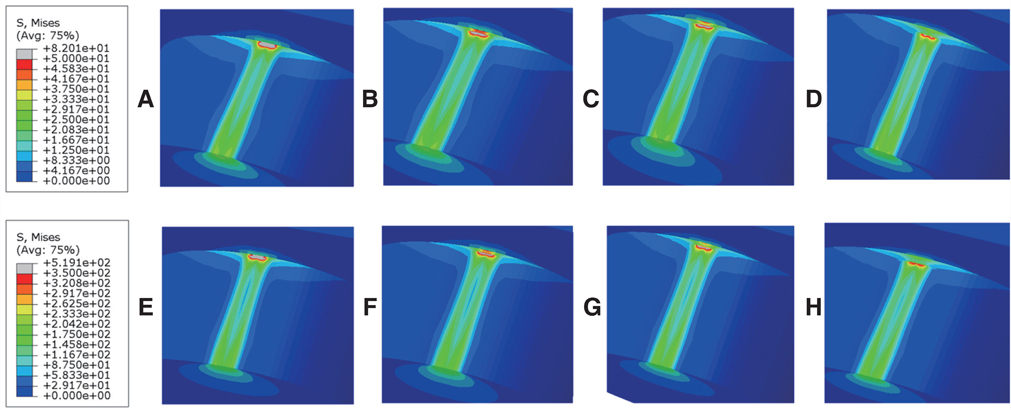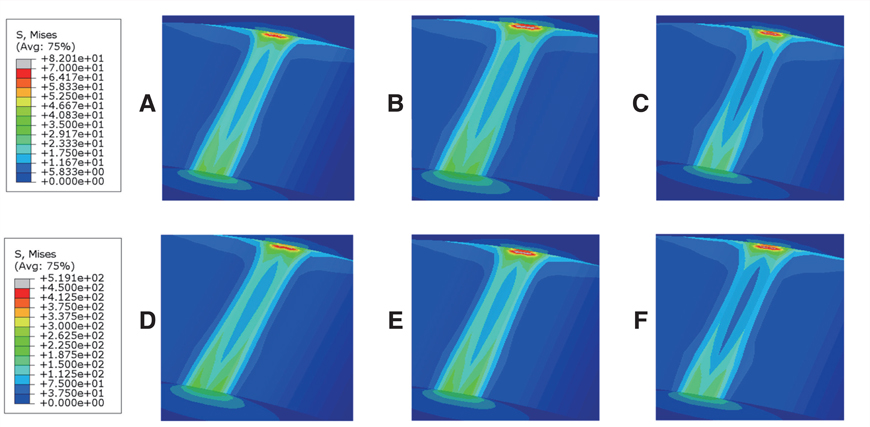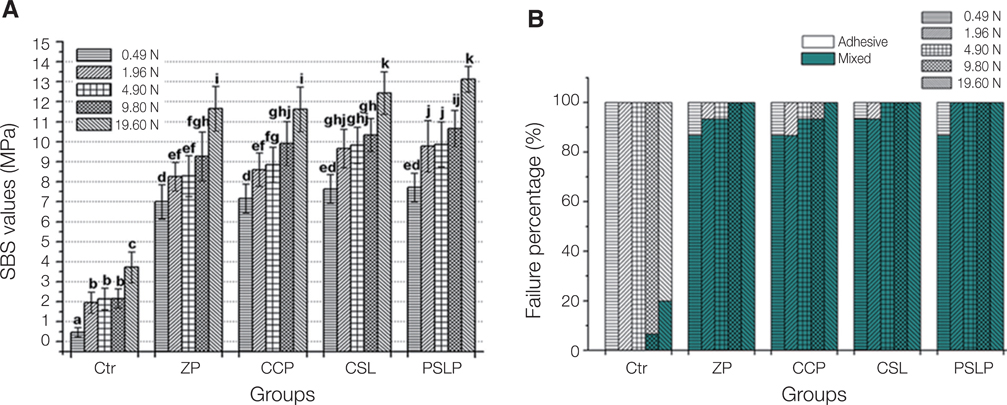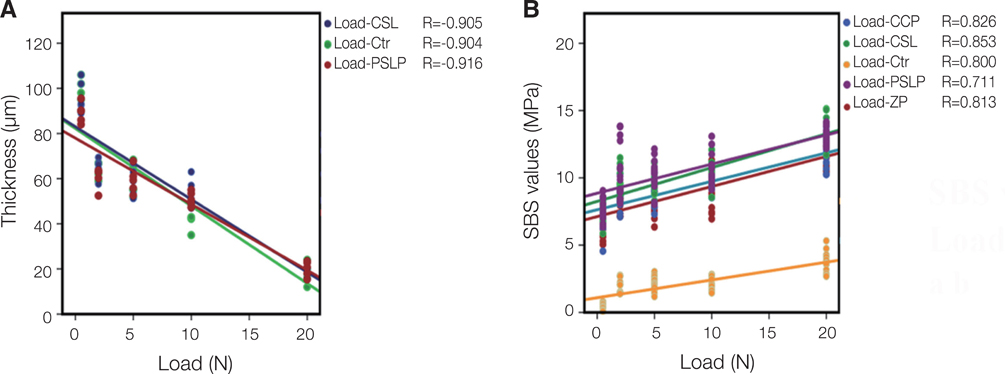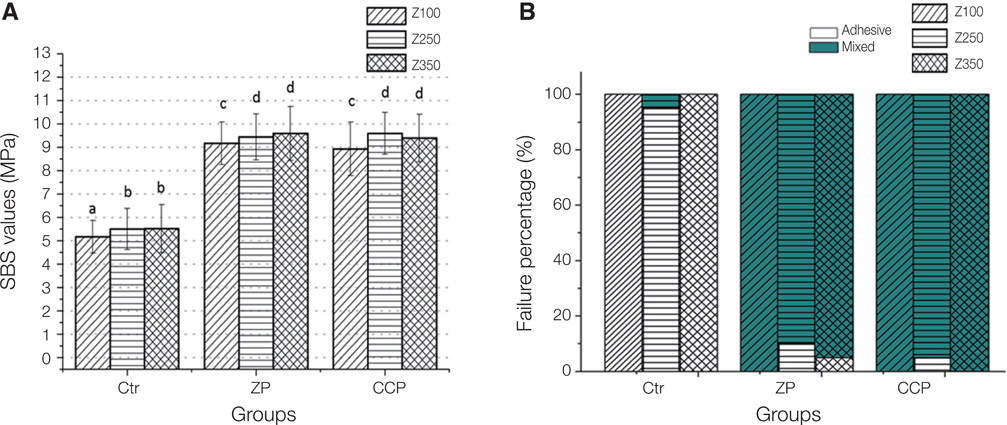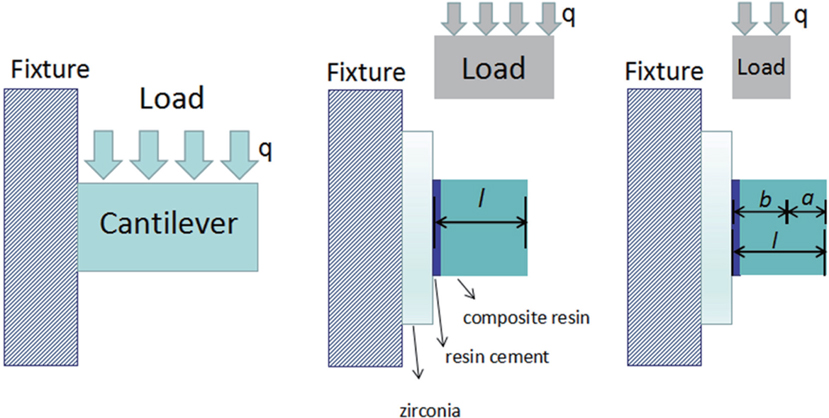J Adv Prosthodont.
2019 Dec;11(6):313-323. 10.4047/jap.2019.11.6.313.
Shear bond strength of zirconia to resin: The effects of specimen preparation and loading procedure
- Affiliations
-
- 1Jiangsu Key Laboratory of Oral Diseases, Nanjing Medical University; Department of Prosthodontics, Affiliated Hospital of Stomatology, Nanjing Medical University, Nanjing, China. xhf-1980@126.com
- 2Jiangsu Key Laboratory of Oral Diseases, Nanjing Medical University; Department of Endodontics, Affiliated Hospital of Stomatology, Nanjing Medical University, Nanjing, China.
- KMID: 2466246
- DOI: http://doi.org/10.4047/jap.2019.11.6.313
Abstract
- PURPOSE
Shear bond strength (SBS) test is the most commonly used method for evaluating resin bond strength of zirconia, but SBS results vary among different studies even when evaluating the same bonding strategy. The purpose of this study was to promote standardization of the SBS test in evaluating zirconia ceramic bonding and to investigate factors that may affect the SBS value of a zirconia/resin cement/composite resin bonding specimen.
MATERIALS AND METHODS
The zirconia/resin cement/composite resin bonding specimens were used to simulate loading with a shear force by the three-dimensional finite element (3D FE) modeling, in which stress distribution under uniform/non-uniform load, and different resin cement thickness and different elastic modulus of resin composite were analyzed. In vitro SBS test was also performed to validate the results of 3D FE analysis.
RESULTS
The loading flat width was an important affecting factor. 3D FE analysis also showed that differences in resin cement layer thickness and resin composite would lead to the variations of stress accumulation area. The SBS test result showed that the load for preparing a SBS specimen is negatively correlated with the resin cement thickness and positively correlated with SBS values.
CONCLUSION
When preparing a SBS specimen for evaluating bond performance, the load flat width, the load applied during cementation, and the different composite resins used affect the SBS results and therefore should be standardized.
MeSH Terms
Figure
Reference
-
1. Blatz MB, Sadan A, Kern M. Resin-ceramic bonding: a review of the literature. J Prosthet Dent. 2003; 89:268–274.2. Özcan M, Bernasconi M. Adhesion to zirconia used for dental restorations: a systematic review and meta-analysis. J Adhes Dent. 2015; 17:7–26.3. Thompson JY, Stoner BR, Piascik JR, Smith R. Adhesion/cementation to zirconia and other non-silicate ceramics: where are we now? Dent Mater. 2011; 27:71–82.4. Wong ACH, Tian T, Tsoi JKH, Burrow MF, Matinlinna JP. Aspects of adhesion tests on resin-glass ceramic bonding. Dent Mater. 2017; 33:1045–1055.5. Papia E, Larsson C, du Toit M, Vult von Steyern P. Bonding between oxide ceramics and adhesive cement systems: a systematic review. J Biomed Mater Res B Appl Biomater. 2014; 102:395–413.6. Sultan H, Kelly JR, Kazemi RB. Investigating failure behavior and origins under supposed “shear bond” loading. Dent Mater. 2015; 31:807–813.7. Braga RR, Meira JB, Boaro LC, Xavier TA. Adhesion to tooth structure: a critical review of “macro” test methods. Dent Mater. 2010; 26:e38–e49.8. Scherrer SS, de Rijk WG, Belser UC, Meyer JM. Effect of cement film thickness on the fracture resistance of a machinable glass-ceramic. Dent Mater. 1994; 10:172–177.9. Urapepon S. Effect of cement film thickness on shear bond strengths of two resin cements. J Dent. 2014; 34:122–128.10. Van Noort R, Noroozi S, Howard IC, Cardew G. A critique of bond strength measurements. J Dent. 1989; 17:61–67.11. ISO/TR 11405. Dental materials - Guidance on testing of adhesion to tooth structure. Geneva; Switzerland: International Standards Organization (ISO);1994. Available at: https://www.iso.org/standard/19347.html.12. ISO/TS 11405. Dental materials - Testing of adhesion to tooth structure. Geneva; Switzerland: International Standards Organization (ISO);2003. Available at: https://www.iso.org/standard/31486.html.13. ISO 29022. Dentistry - Adhesion - Notched-edge shear bond strength test. Geneva; Switzerland: International Standards Organization (ISO);2013. Available at: https://www.iso.org/standard/45285.html.14. Feilzer AJ, de Gee AJ, Davidson CL. Relaxation of polymerization contraction shear stress by hygroscopic expansion. J Dent Res. 1990; 69:36–39.15. Chiba A, Hatayama T, Kainose K, Nakajima M, Pashley DH, Wakabayashi N, Tagami J. The influence of elastic moduli of core materials on shear stress distributions at the adhesive interface in resin built-up teeth. Dent Mater J. 2017; 36:95–102.16. Kanat B, Cömlekoğlu ME, Cömlekoğlu MD, Culha O, Ozcan M, Güngör MA. Microshear bond strength and finite element analysis of resin composite adhesion to press-on-metal ceramic for repair actions after various conditioning methods. J Adhes Dent. 2014; 16:63–70.17. Ayar M, Yesilyurt C, Yildirim T. Effect of different composite placement molds on resin-enamel/dentin shear bond strength. J Res Med Dent Sci. 2016; 4:141–145.18. Chen Y, Lu Z, Qian M, Zhang H, Chen C, Xie H, Tay FR. Chemical affinity of 10-methacryloyloxydecyl dihydrogen phosphate to dental zirconia: Effects of molecular structure and solvents. Dent Mater. 2017; 33:e415–e427.19. Attia A. Bond strength of three luting agents to zirconia ceramic - influence of surface treatment and thermocycling. J Appl Oral Sci. 2011; 19:388–395.20. Gressler May L, Kelly JR, Bottino MA, Hill T. Influence of the resin cement thickness on the fatigue failure loads of CAD/CAM feldspathic crowns. Dent Mater. 2015; 31:895–900.21. Jin XZ, Homaei E, Matinlinna JP, Tsoi JKH. A new concept and finite-element study on dental bond strength tests. Dent Mater. 2016; 32:e238–e250.22. Rezende CE, Borges AF, Gonzaga CC, Duan Y, Rubo JH, Griggs JA. Effect of cement space on stress distribution in Y-TZP based crowns. Dent Mater. 2017; 33:144–151.23. Ha SR, Kim SH, Lee JB, Han JS, Yeo IS, Yoo SH, Kim HK. Biomechanical three-dimensional finite element analysis of monolithic zirconia crown with different cement thickness. Ceram Int. 2016; 42:14928–14936.24. Liu HL, Lin CL, Sun MT, Chang YH. Numerical investigation of macro- and micro-mechanics of a ceramic veneer bonded with various cement thicknesses using the typical and submodeling finite element approaches. J Dent. 2009; 37:141–148.25. Turp V, Sen D, Tuncelli B, Ozcan M. Adhesion of 10-MDP containing resin cements to dentin with and without the etchand-rinse technique. J Adv Prosthodont. 2013; 5:226–233.26. Lüthy H, Loeffel O, Hammerle CH. Effect of thermocycling on bond strength of luting cements to zirconia ceramic. Dent Mater. 2006; 22:195–200.27. de Souza G, Hennig D, Aggarwal A, Tam LE. The use of MDP-based materials for bonding to zirconia. J Prosthet Dent. 2014; 112:895–902.28. Wolfart M, Lehmann F, Wolfart S, Kern M. Durability of the resin bond strength to zirconia ceramic after using different surface conditioning methods. Dent Mater. 2007; 23:45–50.29. Yang B, Lange-Jansen HC, Scharnberg M, Wolfart S, Ludwig K, Adelung R, Kern M. Influence of saliva contamination on zirconia ceramic bonding. Dent Mater. 2008; 24:508–513.30. Chai H, Kaizer M, Chughtai A, Tong H, Tanaka C, Zhang Y. On the interfacial fracture resistance of resin-bonded zirconia and glass-infiltrated graded zirconia. Dent Mater. 2015; 31:1304–1311.31. Phark JH, Duarte S Jr, Kahn H, Blatz MB, Sadan A. Influence of contamination and cleaning on bond strength to modified zirconia. Dent Mater. 2009; 25:1541–1550.32. Vechiato-Filho AJ, Matos AO, Landers R, Goiato MC, Rangel EC, De Souza GM, Barão VAR, Dos Santos DM. Surface analysis and shear bond strength of zirconia on resin cements after non-thermal plasma treatment and/or primer application for metallic alloys. Mater Sci Eng C Mater Biol Appl. 2017; 72:284–292.33. Wilson PR. Crown behaviour during cementation. J Dent. 1992; 20:156–162.34. Wassell RW, Barker D, Steele JG. Crowns and other extra-coronal restorations: try-in and cementation of crowns. Br Dent J. 2002; 193:17–20. 23–28.35. Kim SH, Park CJ, Cho LR, Huh YH. Evaluation of the ceramic liner bonding effect between zirconia and lithium disilicate. J Prosthet Dent. 2018; 120:282–289.
- Full Text Links
- Actions
-
Cited
- CITED
-
- Close
- Share
- Similar articles
-
- Shear bond strength and failure patterns according to the thickness of resin base in bracket bonding
- Effect of various surface treatment methods of highly translucent zirconia on the shear bond strength with resin cement
- Influence of sandblasting and primer on shear bond strength of resin cement to zirconia
- Shear bond strength of veneer ceramic and colored zirconia by using aqueous metal chloride solutions
- The effect of surface treatment conditioning on shear bond strength between zirconia and dental resin cements

